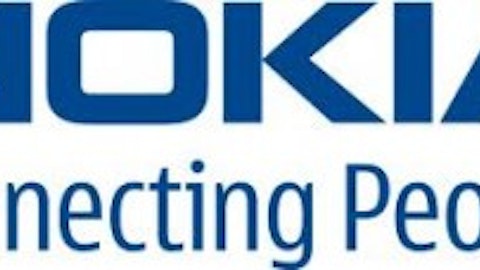In 1998, Nokia Corporation (NYSE:NOK) was considered to be the world’s leading mobile phone manufacturer, a position that managed to keep for almost a decade. However, fierce competition within the telecommunications arena caused Nokia to lose its crown. It went from being every household’s most common brand name to a “fallen angel” fighting for a revival. Nevertheless, despite the overall bearish sentiment over the company’s future prospects, I do believe that there still is hope for this struggling giant.
Falling down the hill
The major hit came with the smartphone revolution and the introduction of’s iPhone in 2007. Since then, Nokia’s market penetration has suffered a steep deterioration, combined with a significant value loss that has left longtime investors praying for a miracle.
At the moment, despite considerable progress in boosting sales volumes, the firm has a steep hill to climb before claiming a meaningful market share.
According to the latest sales data from Kantar Worldpanel ComTech, Windows-based handsets have started to gain respectable market acceptance in several European countries. In particular, for the last three months of 2012, Nokia’s sales in Britain, the country with the highest smartphone penetration in the region, experienced an over 50% acceleration. However, Windows phones’ sales in the top 5 European markets (Germany, UK, France, Italy, and Spain) accounted for roughly 5.4% of all smartphone sales.
In the tough U.S. market, Nokia keeps struggling to attract customers’ interest. According to Kantar’s estimates, the clear winner is Apple Inc. (NASDAQ:AAPL), which appears to be stealing share straight from. About 20% of iOS sales came from former Android users. For the last quarter of 2012, Apple maintained the lead and claimed a market share of over 50%. Google Inc (NASDAQ:GOOG)’s Android operating system remained stable compared to last year and accounted for 44.2% of the market. Windows OS held the third position and claimed a below 3% market share.
For the holiday quarter, Nokia’s North America devices and services volumes were up by 40% compared to the same period in 2011. However, Nokia actually sold less than one million handsets or a fraction of the tens of millions Android and iPhone devices sold for the period. For the full year of 2012, net sales in the U.S. market accounted for 7% of Nokia’s total sales marking a small increase of 3% from 2011. The company’s sales performance was weak considering the sizable marketing investment on WP 8 in the United States and Canada. Nokia confirmed that smart devices volumes were negatively affected by supply constraints. Hence, on the positive side, sales volumes did not match the actual customer demand.
The benefit of the doubt
Over the past couple of years, Nokia has been committed to a transformation process aiming to strengthen its financial position and regain investors’ trust. So, since Nokia is in the middle of a turnaround effort, its quarter-over-quarter financial and operating performance provides the best indication of whether its business strategy has started to pay off.
The firm’s latest earnings release shows signs of improvement, with its non-IFRS results leaving room for optimism. Non-IFRS results exclude one time charges, such as charges associated with restructuring activities, and asset amortization. Thus, they are a measure of underlying performance.
During the past year, Nokia managed to narrow its net losses and somehow control its cash bleeding. It ended the last quarter of 2012 with underlying operating profitability of almost 8% and strengthened its net cash position by €800 million sequentially to €4.4 billion.
These figures do not suggest that Nokia has avoided the danger and is set for a rally this year. Nonetheless, the quarterly improvement of its liquidity could suggest that the company is on the road to recovery. It might be at the early stages of recovery, but still, Nokia seems determined to balance its accounts and shape a gainful outlook. It decided to suspend its dividend payments, and, even though, this was negative news for the market, for Nokia, it was a major step towards financial discipline.
Looking ahead
Looking forward into the future, the company is aiming to capitalize upon opportunities that could generate substantial returns.
The recent deal with is going to be a varying factor in Nokia’s regional competitive position. The leading Chinese mobile services provider agreed to carry the Lumia 920T, the first Lumia handset based on WP 8 software designed for the Chinese market. China Mobile Ltd. (NYSE:CHL)’s network has prevented it from carrying the iPhone. This means that, even though and sell subsidized iPhones, China Mobile’s immense subscriber base gives Nokia a unique competitive advantage. As of December 2012, the company had over 700 million subscribers, including almost 88 million users of 3G services.
Moreover, Nokia is gaining ground in the mapping world, where it has scored noteworthy wins. A year ago, the firm’s Location Platform was selected by Ford Motor Company (NYSE:F) for innovation projects. Just last week, Nokia beat Google to become Toyota Motor Corporation (NYSE:TM)‘s mapping supplier in Europe.
Overall, Nokia has a long way to go before it can augment its competitiveness and support robust revenue growth. Nonetheless, it has not quit the game, and is doing the best it can for a dynamic comeback. I believe that Nokia’s transformation policy, along with the growth potential arising from its strategic alliances, will eventually reward faithful shareholders.
The article Where is Nokia Heading? originally appeared on Fool.com and is written by Fani Kelesidou.
Copyright © 1995 – 2013 The Motley Fool, LLC. All rights reserved. The Motley Fool has a disclosure policy.






